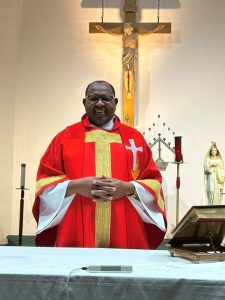To Live the Great Commandment: Love of God and Love of Neighbor
Advent Penance Service, Tuesday, December 16 – 5:00pm, St. Mary’s, Dansville
Mass Schedule for the Nativity of the Lord
Wednesday, December 24
4:00pm – St. Joseph Church
7:00pm – St. Pius V Church
10:00pm – St. Mary Church
Thursday, December 25
9:15am – Sacred Heart Church
A Joyful Celebration: Welcoming Our Shepherd, Bishop Matano
Saturday, December 27th, 4:00 p.m. at St. Mary Church, Dansville, N.Y.
Dear Parishioners,
I am honored to announce that the Most Reverend Bishop Salvatore Matano, Our Bishop will be visiting our parish to celebrate the Holy Eucharist on Saturday, December 27th, 4.00 PM at St, Mary’s Church, Dansville. This will be the celebration of the Feast of the Holy Family, Jesus, Mary and Joseph—OUR PARISH PATRON SAINTS This is a wonderful opportunity for our community to come together and pray with our shepherd. All are invited to join us for this special Mass. The Bishop, as the shepherd of our Diocese, plays a vital role in our faith community, and his visit is a sign of our unity with the wider Church. This Mass is a special occasion for us to experience his ministry firsthand and receive his pontifical blessing. I encourage all parishioners, their families, and friends to attend this significant event. Let us show our warm hospitality and join together in prayer and worship.
From the Desk of Father John
Dear Parishioners,
Advent With the Blessed Mother Mary and Reconciliation!
This year, the Solemnity of the Immaculate Conception of the Blessed Virgin Mary falls on Monday, December 8th. It i The Church celebrates the Solemnity of the Immaculate Conception, the solemn dogma defined by Blessed Pope Pius IX in 1854. As Our Lady Immaculately Conceived is the patroness of the United States of America, this is a holy day of obligation in the United States. Please note our Mass times on Monday, December 8th: 9:00 AM at St. Joseph Church, Wayland; 6.00 PM at St. Mary’s Church, Dansville. Holy Days of Obligation have the same status as Sundays, which means that we have a solemn obligation to attend Mass. We should approach Holy Days of Obligation just as we would our Saturday Vigil/Sunday worship. May Our Lady, the Immaculate Conception, place her mantle of love and protection over our nation. The message of the Solemnity of the Immaculate Conception of the Virgin Mary can be summed up in these words of Angel Gabriel who calls Mary “full of grace” (Lk 1:28): in her there is no room for sin, because God chose her from eternity to be the mother of Jesus and preserved her from original sin. And Mary corresponds to the grace and abandons herself, saying to the Angel: “Let it be done to me according to your word” (v. 38). And the Word was made flesh in her womb. She trusts in God completely. She surrenders to Him in total obedience. “Behold I am the handmaid of the Lord. May it be done to me according to your word!” In those words of obedience, she cooperates with God. At that moment she becomes Mother of God for she provides the human nature while God provides the divine nature. We too are asked to listen to God who speaks to us, and to accept his will; according to the logic of the Gospel nothing is more productive and fruitful than listening to and accepting the Word of the Lord, which comes from the Gospel. The Lord is always speaking to us!
It is most appropriate that this solemnity is celebrated during the Advent season in which we prepare for the coming of Christ. We celebrate this Feast recognizing that the incarnation, redemption, and salvation were made possible through Mary’s fiat, through her words, “May it be done to me according to your word.” And also, the days from December 17 to 24 which recalls the ancient prophecies concerning the Virgin Mother and the Messiah including readings from the Gospel concerning the imminent birth of Christ. This makes the blessed mother a Great teacher of Advent! In this way the faithful, living in the liturgy the spirit of Advent, by thinking about the inexpressible love with which the Virgin Mother awaited her Son are invited to take her as a model and to prepare themselves to meet the Savior who is to come. The season of advent should therefore be considered as a time for celebrating the Sacrament of Reconciliation through the model of the blessed Mother as the Mother of God and the first disciple of Jesus Christ.
During Advent, we hear the Prophets calling us to return to God and experience his mercy. We hear John the Baptist call us to repent and experience God’s mercy. And we anticipate the celebration of God’s greatest act of mercy, the sending of his only Son, Jesus, to be with us. In this celebration, we encounter God’s great mercy in the Sacrament of Penance and Reconciliation. ALL CATHOLICS IN HOLY FAMILY CATHOLIC COMMUNITY ARE INVITED TO A COMMUNAL PENANCE SERVICE WITH AN OPPORTUNITY FOR INDIVIDUAL ABSOLUTION ON TUESDAY, 5.00 PM, DECEMBER 16TH, 2025, AT ST. MARY’S CHURCH. LET US ALL GATHER TO EXPERIENCE THE HEALING POWER OF THE SACRAMENT OF RECONCILIATION. In addition, we will be available to hear individual Confessions on these following dates: Wednesday, 4-7PM December 17th at St. Joseph’s Church Wayland; Thursday, 4-7PM December 18th at Sacred Heart, Perkinsville; Friday, 9-12PM, December 19th at St. Pius Church, Cohocton and Saturday 1-4PM December 20th at St. Mary’s, Dansville.
And so, in the spirit of St. Ignatius, we pray: Lord, help me to make room for you this Advent. Help me to clear out every nook and cranny of my heart and soul and to let go of all things that are not of you. Come into my heart. Give me the grace to respond to you freely and trust you completely. Fill me with your love and your grace. I know that you are all I really need, so please help me to choose you—every time. Let every movement of my heart and soul bring greater glory to you, Lord. Amen. Fr. John
Mission Statement
To live the Great Commandment
Jesus said to him, ‘You shall love the Lord, your God with all your heart,
with all your soul, and with all your mind.’ And
‘You shall love your neighbor as yourself.’
Matthew 22: 37-38

